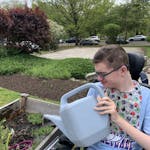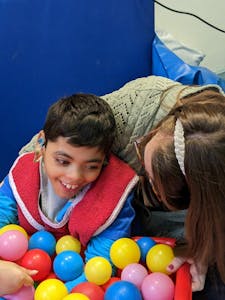By Claire Shrader, OTR/L
With contributions from Rachel Oaks and Sophia Grossman
Take a moment to think about the hats you wear in your own life. You may be someone’s daughter, sister, mother, friend. You may be a cousin, uncle, grandparent, or nephew. You may be someone’s teacher, counselor, doctor, or nurse. You may be a student of art or Spanish or photography.
Each of us has one unique life, filled with a multitude of hats or roles that we identify with, balance, and glean purpose from. The Occupational Therapy Practice Framework defines roles as “….an aspect of occupational identity – that is, they help define who a person, group, or population believes themselves to be on the basis of their occupational history and desires for the future.” (American Occupational Therapy Association, 2020). Occupational therapy considers the many roles of our students in order to support them in their goals, hopes, and dreams for the future.
One of my favorite parts of being an occupational therapist is empowering the children and adults that I work with to believe that they can be or do anything they want to. And it is my job, as their occupational therapist, to ensure they are provided with the support they need to achieve those dreams. This may entail designing opportunities to practice relevant skills, facilitating exploration of roles they may love, and modifying both the activity and the environment to promote their success. Working with individuals with physical disabilities allows me the opportunity to creatively problem-solve in partnership with the individuals I serve. My students and their families are hands down the best problem solvers and are the experts in the process of making their dreams accessible.
As the sister to two brothers with Cerebral Palsy, one of the roles I am especially passionate about supporting is that of a sibling. I value getting to know and understand my students’ own relationships with their siblings and facilitate engagement that is motivating for them. For example, creating a card for their sibling’s birthday, composing and programming a message in their communication device with a congratulatory message after their sibling won a softball game, or exploring adaptive gaming by using a switch or eye gaze device to participate in a shared interest with a sibling. Beyond the role of siblings, it has been so exciting to support my students in other roles within their family like working on the skills needed to independently video call a parent, problem solving ways to drive down the aisle at a parent’s wedding and throw flowers as the flower girl, or using switch-activated software to create a card for Father’s Day.
And of course, I would be remiss if I did not touch on one of the most important roles we work on in the school setting: that of student. It is a privilege to collaborate with each student’s family and educational team to help them participate and thrive throughout their school day. In Occupational Therapy, we empower students to be active within their role as learners to support their success and love for the learning process.
Occupational Therapy allows our students to not only find the roles they are passionate about and the hats they want to wear, but also gives us the privilege to help them ensure the myriad of their hat choices fit them to perfection.
Claire Shrader is an Occupational Therapist at HMS School with her master’s degree from Thomas Jefferson University. She is the triplet sister to two brothers with Cerebral Palsy and passionate about disability advocacy and family-centered care.


